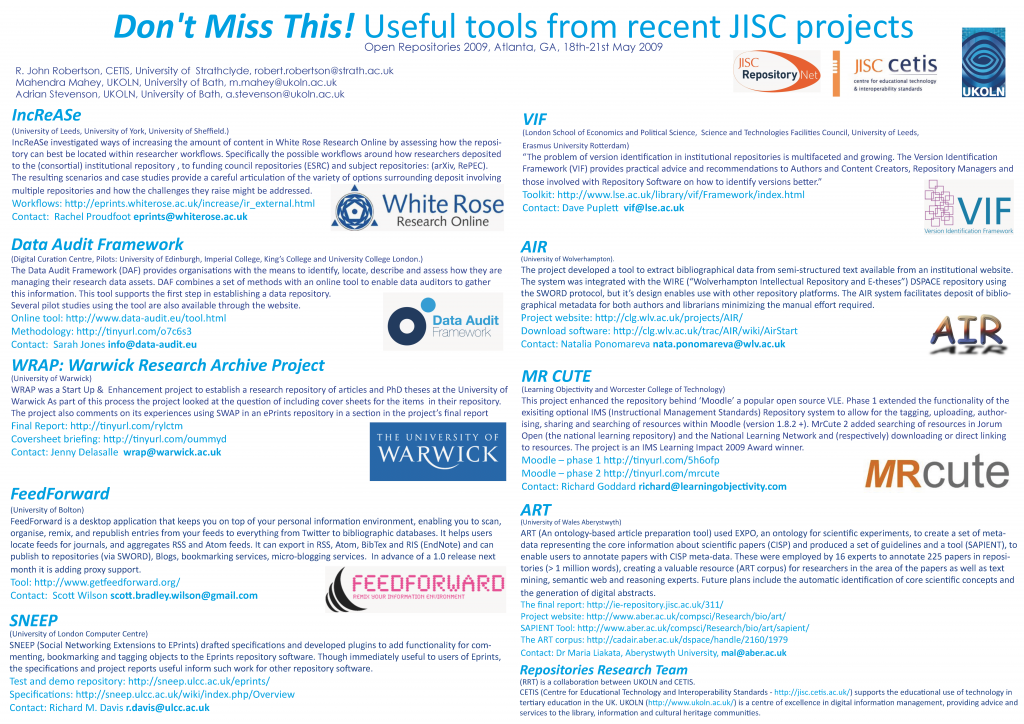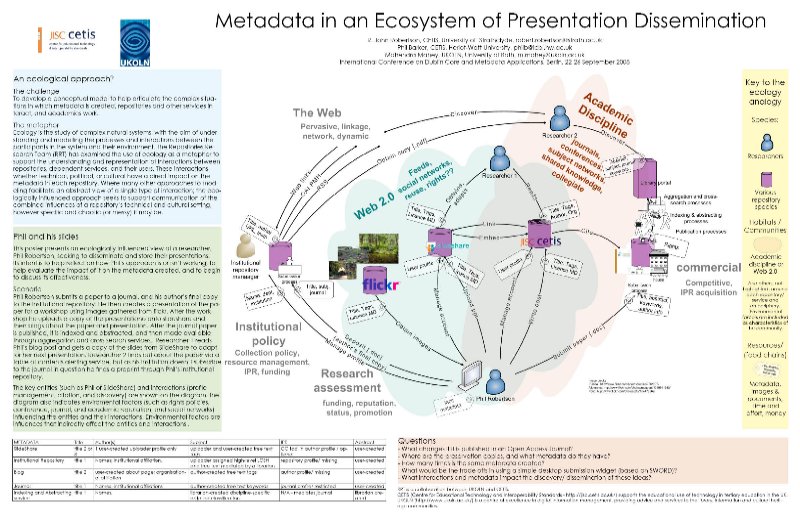Held at Georgie Tech, Open Repositories 2009 hosted 326 delegates form 23 countries. The conference ran smoothly and managed to provide robust wifi for anyone who wanted it. The conference dinner was held at the Georgia Aquarium; the aquarium was inspiring (though the theme music was a bit much after a while) and the dinner was splendid.

Atlanta Aquarium Jellyfish
The conference proper once again provided a state of the art view of repository software and emerging trends in institutional (& organisational) approaches to managing digital assets. It proved to be a thought-provoking few days.
Of particular note was the impact of SWORD which was, frankly, everywhere. I’m not going to say a great deal about it beyond noting that:
- at least for this conference, it has become the de facto standard for deposit tools
- there are now a good number of desktop tools and application plug-ins supporting SWORD deposit
It will be interesting to see how it evolves from here. For those of you on Twitter @swordapp tweets updates of SWORD related developments.
[disclaimer: I have in the past worked with both of the SWORD project managers]
Another feature of the conference was another RepoChallenge. Sponsored by JISC and Microsoft this again attracted a lot of interest; David Flanders, the organiser, has blogged about the event, participants, and winners (Winner: MentionIt by Tim Donohue; Runner up: FedoraFS by Rebecca Koesar)
http://dev8d.jiscinvolve.org/2009/05/20/repochallenge-winners/.
I’ve got about 8 pages of tweets covering the rest of the conference – rather than bore you with I’ll offer this wordle as a summary and instead comment on what I felt to be the most important developments.

I’ll also note in passing the approach one session took to supporting twitterers – programme session 7 a – chaired by Robert Macdonald http://twitter.com/mcdonald/ added a hashtag for their session #ps7a alongside #or09 this would allow the seperate retrieval and analysis of that sessions tweets from the more general stream of conference tweets.
Trends that I noticed emerging from the conference:
- managing datasets is firmly entering institutional agendas. In part this is pushed by funding bodies in part through a desire for more open data.
- the merger of the DSpace and Fedora organisations should provide a more stable future for the software platforms and in the longer term greater opportunities for collaborative development.
- California Digital Library (John Kunze’s presentation) are shifting to repository microservices and beginning to move beyond single software products. (I couldn’t help being reminded of the eFramework but CDL seems to be beginning with a specific local business case)
- there appears to be a growing interest in Open Access journal publishing in North America: both in the production of new journals and through collaboration with university presses; Microsoft Research have also developed a hosted open access journal service.
- Zentity – it’s is unclear yet to what extent Microsoft Research’s repository will gain traction in the community but the impact of their engagement with the sector and tools like Zentity and the SWORD deposit plugin for MS Office is significant in itself.
- @mire and mediashelf are two commercial companies heavily involved in the development of additional functionality or support services for DSpace and Fedora (respectively). It was striking how many projects doing innovative stuff had worked with one or other of them. Eprints has offered customisation, hosting, and related services for a while but that initiative emerged from the ECS department at Southampton where the software originated, whereas these two companies seem to have emerged more independently.
It was also interesting to note a few presentations touching on managing learning materials.
Other blogs reporting on OR09 are listed at:
http://repositorynews.wordpress.com/2009/05/28/open-repositories-2009/



